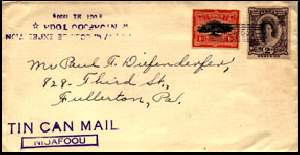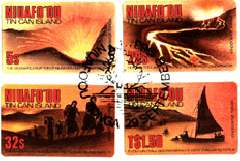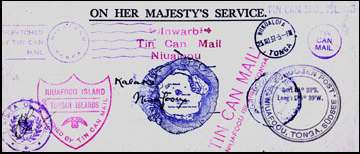The story of Tin Can Mail
In the years between the two world wars, few cruise ships touring the Pacific could hardly dare to leave the tiny island of Niuafo'ou off their itinerary.
"Why have I never heard of it?" you may ask, "and what made the ships stop going there? Good questions; and the strange answer is that the islanders built an airport.
The story begins back in 1882 when William Travers, a plantation manager, found himself 'marooned' on this tiny doughnut-shaped island half way between Fiji and Samoa. It is nothing more than the tip of a volcano jutting out of the vast blue waters of the Pacific. Just a couple of miles out, he could see the passenger liners steaming past, but none ever called because the island had no harbour and no beaches. In fact the steep sides plunge six miles down to the bottom of the Tongan Trench making it impossible to anchor and hard to land even a rowing boat.
|
The only white man on the island, Travers resented being unable to communicate with the outside world. So when the need to contact his company in Australia became desperate, he came up with an ingenious plan.
He wrote to the Tongan postal authorities asking them to seal his mail in a ship's biscuit tin, and arrange for the captain of one of the Union Steamship Company vessels to throw it overboard as they passed the island on their way between Suva and Fiji. These ships traded regularly between the islands of the Pacific. If the captain would give a hoot on the ship's siren, he would send a swimmer out to collect the tin.
|

|
|
Carefully he wrapped this letter in grease-proof paper and tied it to a short stick. He approached the strongest swimmer on the island and asked him to swim out to the next ship and hand his letter to the captain. In this way Tin Can Mail was born. It was to become a regular happening after Aurthur Tindall set up as a trader on the island some years later.
The island's fisherman were well used to swimming in the dangerous shark-infested waters, which they did clinging to a long buoyant fau pole cut from a type of hibiscus. By putting a pole under one arm they could float and fish for hours on end.
However, the strong currents meant that a swimmer might often struggle for up to six hours to retrieve a mail tin dropped from a ship only a mile off shore. In stormy weather it proved impossible to collect the mail and any number of other methods were tried. In 1902 William Edgar Geil wrote in his book 'Ocean and Isle' that he had watched the captain send letters to the island by rocket. On this occasion the attempt was successful, but often the rocket overshot the island altogether, landed in the lake in the centre, or just got lost in the undergrowth. On a previous occasion the package of letters had burst into flames en route. The arrival of the rocket was an event that caused the entire population to down tools and watch. Then began the mad scramble to retrieve the package and collect the reward.
Charles Ramsay, who had been hospitalised for several years after being severely gassed in the First World War, came to Niuafo'ou as a plantation manager in 1921. He too needed to communicate with the outside world and took over the task of swimming the mail. The only white man to do so, he went out 112 times in all weathers.
If a ship happened to pass at night it would blow its siren and the swimmers would go out as a group, one carrying a lamp. Back on shore they would build bonfires to guide the swimmers home to the tiny island.
|
|

|
The next phase in the Tin Can Mail saga came when Walter George Quensell arrived on the island in 1928. He quickly realised that philatelic interest could be generated by this unique method of delivering the mail and so, with a child's printing set, he produced a rubber stamp which read "TIN CAN MAIL" and applied it to all outgoing letters.
|
|
The total eclipse of the sun in 1930 was best viewed from Niuafo'ou and had a major impact on what was now known as Tin Can Island. Paul Diefenderfer, the Director of Education in Suva, accompanied the American expedition as chief photographer. He liked the idea of cachets and the scientists were quick to produce one of their own to commemorate the occasion. Diefenderfer also persuaded Quensell to develop his idea further and have rubber stamps made in New Zealand.
Inevitably one of the 'postmen' was attacked by a shark and died. On his deathbed he confessed that, in a temper, he had opened the tap on one of the huge concrete fresh water tanks. This was a great crime because the island had no fresh water and rain water had to be collected during the hurricane season and stored. The Chief pointed out that what he had done threatened the very existence of the inhabitants and said that the Gods had justly punished him.
As it happened there were no further incidents in which sharks were involved - and no further tampering with the water supply!
|
|
Queen Salote, however, was very upset and ordered that in future, mail was to be collected by outrigger canoe. This was much more difficult because the boats had to be thrown from the cliff top. The crew had then to jump into the water and climb aboard.
There were no restrictions on fishing from a fau pole and it is thought that many of the swimming mailmen continued to collect the mail this way when no one was looking. At one stage they threatened to strike and it was only averted by Quensell cutting the word 'canoe' from all his rubber stamps.
Quensell arranged with ships' captains that if passengers mailed their letters 'in the Tin' together with 6d to cover stamps and costs, he would apply his cachets before posting them on. Captains soon applied rubber stamps of their own telling the story of Tin Can Island and the ship which carried the letter. The history of all these cachets has now become a study in itself.
|
 |
|
Naturally the passengers loved to watch the 'natives' collecting the mail and soon most of the cruise liners made a point of calling at Tin Can Island. People wrote from many parts of the world enclosing their 6d and a self-addressed envelope. By enclosing £1 one could get the entire set of definitives and registration too!
|
 |
In later years Quensell developed cachets in a variety of languages. Despite the impression this created that Tin Can Mail was a philatelic gimmick, it was still the only way the islanders could get their letters. For over 100 years, even Government correspondence with officials on the island, came in, and went out, in tin cans and did not escape Quensell's ever-more ornate cachets - such as the example below to the Chief of Police.
|
|
The islanders benefitted greatly from the interest that this generated because, instead of a vessel visiting once a year to collect the copra harvest, they now had visits from cruise ships as often as twice a week. These brought, not only the mail, newspapers and magazines, but fresh meat and vegetables, as well as news of the outside world.
|
|
Being a volcano, Niuafo'ou was subject to constant tremors but in 1946 there was a huge eruption and half the island was buried under lava. Miraculously no lives were lost but within twenty minutes, the recently built radio station and Quensell's house with his entire collection of Tin Can Mail, were among the casualties. It was three days before a passing plane saw the eruption and radioed for help.
With Krakatoa very much on their minds, the Government ordered the evacuation of the entire island, and it was to be 12 years before the islanders would be permitted to return and harvest their valuable copra crop. By that time Quensell had died.
|

|
 |
In a letter, Quensell told a friend that during his 27 years on the island, he had sent more than one and a half million letters to 148 nations and states. His cachets became ever more elaborate, such as this delicate large map of the island showing its sulphurous lake. He wrote that towards the end, excursion vessels had brought as many as 40,000 letters a visit, mostly from the USA.
It was not until 1962 that the Matson line, responding to pleas from the islanders, resurrected the Tin Can Mail, inviting Quensell's son, now living in Aukland, to sign some commemorative covers.
|
|
The islanders really needed the contact with the outside world and the move was a great success. However, the visits proved so popular with the cruise passengers that the genuine mail was swamped, making commercial covers from the period extremely rare.
Tin Can Mail continued for over 100 years, in fact until 1983, when an airfield was built on the island and, sadly, it all came to an end.
|
|






